Related Topics
Giant Hogweed
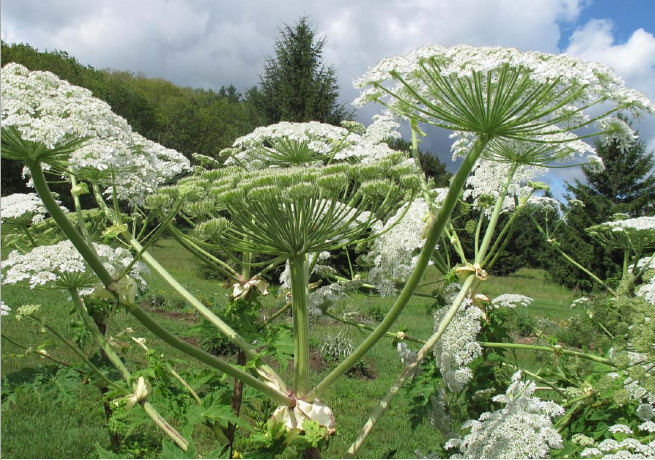
Giant hogweed has the potential to spread readily and grows along roadsides, ditches and streams. It invades old fields and native habitats such as open woodlands.
There are a number of plants that look very similar to Giant hogweed such as Cow parsnip, Purplestem angelica, Woodland angelica, Valerian, Lovage, and Queen Anne's-Lace (also known as Wild carrot). However, these plants are not as large as a mature Giant hogweed, which grows up to 5.5 metres tall under ideal conditions. The white flower clusters resemble those of Queen Anne'sLace, but tend to be more widely spaced and can form a flower-head almost one metre wide.
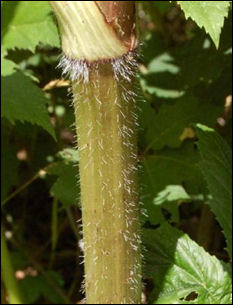
Seeds may take several years to germinate and are viable in the soil for up to 15 years. During the first year, the plant produces a rosette of leaves up to one metre high. After 2 to 5 years the plant produces flowers. As it grows a large root, thick hollow stems and large lobed leaves are formed. The stems of the plant are covered with reddish-purple flecks and stiff hairs filled with sap. Sap may also collect in the hollow stem bases. Giant hogweed flowers once in its lifetime, unless the flower clusters are damaged before opening. Once the plant produces seeds it dies. Each plant can produce up to 120,000 winged seeds (typically 50,000). Seeds dropped in streams can float for three days. They can move long distances via water in ditches and streams. Seeds can also be spread up to 10 metres by the wind.

Note jagged edges of mature leaves
The Dangers: (Source: U.S. Dept. of Agriculture)
Giant hogweed can cause a significant reaction if sap from a broken stem or crushed leaf, root, flower, or seed comes into contact with moist skin (perspiration will suffice). Irritation is NOT immediate.
Within 24 hours, burn-like lesions form, followed by large, fluid-filled blisters within 48 hours. On rare occasions, the burns and lesions may require hospitalization for treatment. Even minute amounts of sap in the eyes can cause temporary or permanent blindness.
The Antidote:
Immediately wash skin thoroughly with soap and water, removing the sap and hopefully preventing any reaction with subsequent exposure to sunlight. Treatment with prescription topical steroids early on may reduce the reaction.
Removal:
If you have Giant hogweed on your property, it is recommended that you hire a professional exterminator to remove it. The plant will be removed safely and as few seeds as possible will be spread. Reducing a large population of Giant hogweed will take a long term commitment. The best time to remove the plant is in late April or early May. It is usually less than 30 centimetres tall, easier to dig up, and more susceptible to herbicides at this time of year. It is also cooler in the spring than in the summer so wearing protective clothing is more comfortable.
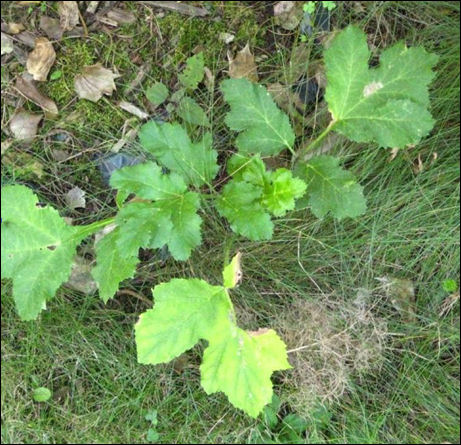
Right: Young hogweed seedling
Protective clothing: Wear protective clothing, including waterproof gloves, long sleeve shirts, pants, and eye protection. It is ideal to wear a disposable "spray suit" coverall over top of your normal clothing (spray suits are commercial grade waterproof coveralls). Remove protective clothing carefully to avoid transferring any sap from your clothing onto your skin. Wash your rubber gloves with soap and water, and then take off your spray suit or outer clothing. Wash your rubber gloves again and then take them off. Finally, take off your protective eye wear. Put non-disposable clothing in the laundry and wash yourself immediately with soap and water.
Mechanical control:
Spring Removal (i.e. early May):
Use a spade to remove as much of the root as possible. Digging up older plants can be difficult since roots can grow deeper than one metre. The plant might re-grow from the root and you may need to dig repeatedly to remove it completely. Or, you can cover the dug area with black plastic to smother out new growth. If it's possible to use machinery, mow new growth every two weeks.
Summer Removal (i.e. early July):
" Plants without flowers: If the infestation is small dig the stems and roots out and dry them thoroughly before disposing of them.
" Plants with flowers: To prevent seeds from growing and spreading, remove flower heads before they ripen (when they are white). Note: If the flower heads have changed from white to green, seeds are being produced and it will be very hard to remove the seed heads and/or cut the plant without spreading the seeds. Return to the area regularly and remove any new growth.
Control Using Herbicides:
Herbicides can be used to control plants (like Giant hogweed) that are poisonous to the touch. Glyphosate is effective at controlling the top-growth of Giant hogweed. Foliar herbicide applications are most effective in spring on actively growing plants, followed with a subsequent summer application for missed plants or plants that have regrown. Since glyphosate is non-selective and removes only the green vegetation that it comes into contact with, new seedlings will often germinate and emerge after glyphosate has been applied. If areas treated with glyphosate are covered in mulch 10 to 14 days after application, it will reduce seedling germination and growth. Herbicide treatments may need to be repeated in following years. If a plant is flowering, herbicides are not effective and control methods should focus on carefully removing the flower heads. Follow label directions and relevant provincial and federal legislation when using herbicides.
Disposal:
Do Not Burn. Do Not Compost. Carefully remove flower heads from stems and place them in black plastic bags. Make sure not to drop any seeds while you are doing this. Seal the bags tightly and leave them in direct sunlight for about a week. Allow stems and roots to dry out thoroughly before disposing of them. Call your municipality to find out if bags containing Giant hogweed can be sent to your local municipal landfill site.
In the event of any direct exposure/contact to this plant If you get sap on your skin wash the area well with soap and water. Keep the affected area out of the sun. If photo dermatitis (inflammation of the skin caused by exposure to sunlight) occurs, see a doctor. If you get sap in your eye, flush your eye with water immediately and see a doctor immediately.
If you think you have Giant hogweed on your property or if you see it in your community please call the Invading Species Hotline at 1-800-563-7711 or report your sighting online at www.invadingspecies.com/Report.cfm
Phragmites
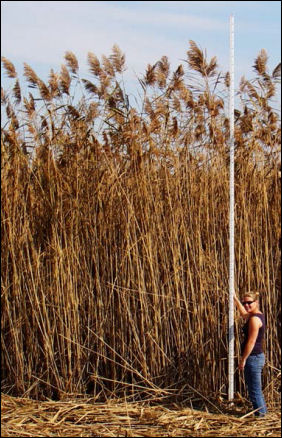
This plant destroys wetlands!
Phragmites (frag-my-tees) is an invasive perennial grass that has caused severe damage to wetlands and beaches in Ontario for several decades. In 2005, it was identified as the nation's "worst" invasive plant species by researchers at Agriculture and Agri-food Canada. Despite this designation, invasive Phragmites is still sold as an ornamental plant in some garden centres. There's a large area of phragmites on the side of Forty Hills Road, near the north end of it.
We do have native phragmites that are much smaller and that do not threaten the plants or wildlife nearby. Invasive Phragmites has an intricate system of specialized roots that secrete toxins into the soil to impede the growth of and kill neighbouring plants.

Stands of invasive Phragmites reproduce primarily through the extension of runners or through the dispersal of root fragments that readily grow into new plants. Root fragments can be transported by flowing water or winds or moved around by animals. Human actions, such as the horticultural and agricultural trades or the movement of boats, trailers, and ATVs, can also disperse root fragments. Once it is established, a new invasive Phragmites plant can grow several metres in height and produce up to 2000 seeds every year.
The Dangers:
- Invasive Phragmites grows in dense stands that crowd out native vegetation, resulting in decreased plant biodiversity.
- Generally, invasive Phragmites stands provide poor habitat and food supplies for wildlife, including several species at risk.
- Invasive Phragmites grows very quickly. Areas with stands of invasive Phragmites have lowered water levels because water is transpired at a faster rate than it would be in an area of native vegetation. This can lead to the drying of wetlands and the loss of hydrological functions such as water retention and filtering.
- Stands of invasive Phragmites are composed of a high percentage of dead stems, with a low percentage of live growth. Dead stems are dry and combustible, increasing the risk of fires.
- The stems of an invasive Phragmites stand decompose very slowly. This results in a high proportion of dead stems that slow the release of nutrients back into the ecosystem.
- Invasive Phragmites can negatively affect agriculture, lower property values, cause road safety hazards, and impact recreational activities such as swimming, boating, and angling.
Dealing With It
Phragmites is a serious problem. It grows so dense that wildlife cannot get through it. And when it's disturbed, it flourishes by dispersing root fragments onto any human or animal who struggles through it. Professional removal is usually required, according to the MNR. Nevertheless, here's some pointers from their web site:
- Learn how to identify invasive Phragmites and how to avoid accidental distribution of root fragments and seeds.
- Don't plant invasive Phragmites. Gardeners should use only native plants in their water gardens.
- Avoid leaving designated trails or entering areas containing invasive Phragmites. Disturbance to natural areas can encourage the spread of this plant. When leaving an area containing invasive Phragmites, brush off clothing and clean equipment on-site to avoid the transfer of seeds to new areas. Remove all visible portions of plants and dispose of them in the garbage.
- Don't attempt to compost invasive Phragmites. Seeds and rhizomes can survive and grow in a compost heap. Dispose of invasive Phragmites in the garbage or at a landfill, or by drying and burning the removed stems.
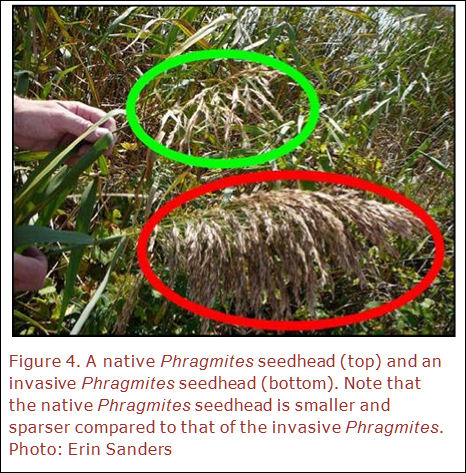
If you discover some phragmites, please report it to the Invasive Species Hotline at 1-800-563-7711.